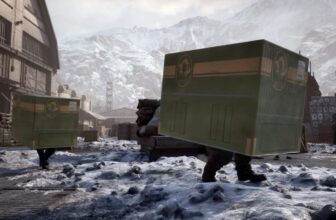
Check out our latest products
![]()
Aquatic stalking is a hunting technique used by polar bears to catch seals. Unlike the traditional method of waiting by breathing holes in the ice, aquatic stalking involves the bear swimming stealthily through open water or diving under ice to approach seals resting on the ice’s edge. Polar bears use their white fur as camouflage in snowy or icy environments, allowing them to blend in and get closer without being detected. When close enough, the bear launches a sudden, explosive attack, often breaking through the ice or lunging from the water to catch the seal. This method requires patience, strength, and precise timing, as seals are highly alert and quick to escape into the water.
Aquatic stalking is a hunting technique used by polar bears to catch seals. Aquatic stalking is a hunting technique used by polar bears to catch seals. Unlike the more passive method of waiting by breathing holes in the ice, aquatic stalking involves the bear swimming stealthily through open water or diving under the ice to approach seals resting at the ice’s edge.
Aquatic stalking is particularly seen during the warming months of spring (April and May) in regions where sea ice fasten to the land is still present, such as the protected inner fjords of the Spitsbergen area. This behavior demonstrates the polar bear’s adaptability and skill as a top predator in the Arctic ecosystem.
Polar bears use aquatic stalking to hunt seals, especially in spring when seal pups are born. The bears know this is a key time—female bearded seals often leave their newborn pups resting alone on the ice while they circle nearby in the water, checking for predators. Polar bears are widely aware of this behavior.
![]()
Once it chooses a target, the bear quietly enters the water to get closer from one ice flow to the next. Here, this incredibly clever bear is very gently getting out of the water before entering again, swimming slowly and silently beneath the surface to reach its next ice platform.
From a distance, the polar bear may spot the seal pup resting on the ice from above the surface. But before making a move, it dips its head into the water to look beneath. By watching the mother seal swim below and tracing the shapes of the ice from underneath, the bear creates a mental map of the area. This behavior helps the bear pinpoint its position once it’s underwater, so it can swim silently and approach the exact spot beneath the ice where the pup is lying above — ready to strike with precision.
![]()
Polar bears are not only powerful swimmers but also highly strategic hunters. One of their remarkable abilities is to stay submerged underwater for up to two minutes, allowing them to silently approach prey without being detected. The bears can dive and resurface at a calculated distance, minimizing noise and visibility.
In addition to their breath-holding capability, polar bears are known to travel large and deliberate distances in the water to reach specific points of attack. These locations are not chosen randomly — they often target areas where seal activity is high, such as cracks in the ice, haul-out zones, or breathing holes. By combining swimming endurance, patience, and precise timing, polar bears can surprise their prey with deadly efficiency.
The strike; this exact moment of the polar bear’s explosive appearance—the brutal climax of a long underwater stalk. After being briefly diverted by the mother seal’s appearing here on the right side, and her desperate attempt to protect her pup, the bear launches from the icy water with force and precision.
The pup, resting on the ice floe, becomes the target in this split-second of violent motion. It’s a tough, emotional moment that reflects the harsh survival dynamics of the polar world, where every life hangs in a fragile balance.
![]()
The apex predator rises slowly from the cold water onto the ice, its broad back to us. In its mouth, a bearded seal pup hangs turned toward its fate. There is no struggle, no fight — only a soft stillness as if the pup has already let go, as if the world, so new and full of light just moments ago, had suddenly turned too heavy to bear.
A kind of gentle surrender that speaks louder than struggle ever could. The face of a soul that trusted the world — and was met with silence.
![]()
The power of the scene lies in its brutal stillness — the final moment suspended in time, just before the inevitable. The bearded seal pup lies sprawled on the ice, its wide eyes fixed on the open water freedom.
![]()
The bear’s claws dig into the ice, muscles coiled with raw force, jaws parted. The seal’s last sight is not the horizon, not the cold Arctic sky, but the unstoppable force of nature bearing down. It is the split second where survival ends and silence takes over — a moment where everything changes forever.
Spring in Svalbard is a pivotal season for polar bears, offering essential hunting opportunities before the rapid retreat of fast ice. Fast ice, the sea ice attached to coastlines and fjords, provides a vital platform for polar bears to hunt their primary prey — seals. In early spring, seals haul out onto the ice to rest and give birth in snow dens, making them more accessible to polar bears. The bears rely heavily on this period to build up fat reserves that will sustain them through the leaner months when hunting becomes more difficult.
As temperatures rise, the fast ice begins to break up and drift away from the land, reducing the area over which polar bears can effectively hunt. This shrinking ice cover forces the bears to adapt quickly, often requiring them to travel longer distances in search of food, either across increasingly unstable ice. Each day of hunting opportunity becomes more valuable, as successful hunts now must compensate for the longer periods of food scarcity later in the year.
![]()
An eventual rise in average spring temperatures is likely to trigger an earlier and faster retreat of the ice, shortening the hunting season even further. This accelerating process threatens the delicate balance of survival in the Arctic.
In this way, spring represents both a brief window of abundance and a turning point, emphasizing the fragile balance polar bears must navigate in a rapidly changing Arctic environment.
Black and White Images
![]()
![]()
![]()
![]()
![]()
Image credits: Virgil Reglioni (Instagram)
About the Author: Virgil Reglioni is an expedition leader and award-winning photographer specializing in polar landscapes and the Northern Lights.

![[2025 Upgraded] Retractable Car Charger, SUPERONE 69W Car Phone Charger with Cables Fast Charging, Gifts for Men Women Car Accessories for iPhone 16 15 14 13 12, Samsung, Black](https://i1.wp.com/m.media-amazon.com/images/I/61SaegZpsSL._AC_SL1500_.jpg?w=300&resize=300,300&ssl=1)



![[True Military-Grade] Car Phone Holder【2024 Stronger Suction & Clip】 Universal Cell Phone Holder for Car Mount for Dashboard Windshield Air Vent Long Arm Cell Phone Car Mount Thick Case,Black](https://i2.wp.com/m.media-amazon.com/images/I/715PBCuJezL._AC_SL1500_.jpg?w=300&resize=300,300&ssl=1)
![[エレコム] スマホショルダー ショルダーストラップ 肩掛け ストラップホールシート付属 丸紐 8mm P-STSDH2R08](https://i3.wp.com/m.media-amazon.com/images/I/51BMFf06pxL._AC_SL1500_.jpg?w=300&resize=300,300&ssl=1)







